
Official Edgar Rice Burroughs Tribute and Weekly Webzine Site
Since 1996 ~ Over 10,000 Web Pages in Archive
Volume 2856
AN UNNATURAL HISTORY OF
THONGOR'S LEMURIA
By Den Valdron

 |
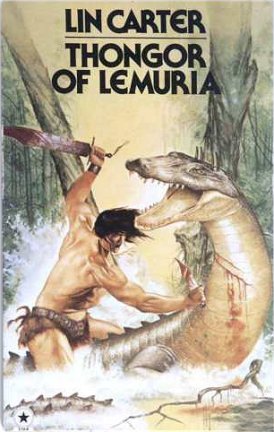 |
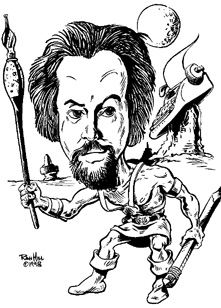 |
I think that I might be biting off more than I want to chew here.Here’s the deal. Thongor of Lemuria was one of Lin Carter's more famous and more ambiguous creations. (Quick: Who remembers Prince Zarkon? Yeah, I thought so.), not least because Carter and Thongor are so intimately woven with Robert E. Howard and his creations, Conan and Kull.
Thongor was created originally as Lin Carter's tribute to Howard's Conan in 1965, and starred in a series of novels between 1965 and 1970. He also appeared in Carter's short stories as late as the 1976, and in a Marvel comic book run.
Thongor seems to have been Carter's first published novel, the beginning of his career. I assume then, that he was probably playing around with it for at least a couple of years before that. The idea of Thongor in Lin Carter's mind may have gone as far back as 1962 or earlier. Thongor seems to have had some significance to Carter as a character, as noted, his fictional career spans 11 years of Carter's life. Most interestingly, Carter actually rewrote and expanded his first two Thongor novels in 1968. I'd argue that Thongor was perhaps a little closer to Lin Carter's heart than any of his other characters or series.
But Thongor was also explicitly a descendant, perhaps even a clone of Conan, something that Carter would have been the first to admit. Carter made no bones, he was an ultimate fanboy, he loved what he loved... Burroughs, Howard, Lovecraft, Oz, the old pulps, and wrote in those styles.
The pros and cons of Lin Carter's personal interests and writing is a subject for another day. But we can assume that he wrote what he loved, and if he was a hack as some might say, then he's a sincere hack and not just some guy cashing a check.
He loved Thongor, and he loved the writers and characters that inspired Thongor.
So, I don't know whether its tragedy or comedy that Lin Carter, along with Sprague L. Camp, inherited the Conan franchise, and got the job of 'posthumous collaborations', editing and organizing existing stories, finishing Howard's unfinished stories, fleshing out Howard's notes into new Conan adventures or just writing brand new ones.
For a fanboy like Carter, this must have been a dream come true, a chance to work with the masters that he loved, to hitch his career and name irrevocably to that star... And get paid for it.
But on the other hand, I think it made his relationship with Thongor, more complex and perhaps unsatisfying. Thongor, derivative as it was, was at least his creation. Now he was toiling in someone else’s garden. There were interesting reverbations: Lin Carter's Thongor comic book deal was thrown over for a Conan comic, the Thongor deal was only a negotiating ploy. On the other hand, it was probably only the success of the Conan movies that lead to any interest in a Thongor movie. At least one of Carter's own stories, originally written for Thongor got reworked into a Conan story.
Carter himself appears to have attempted to stitch Thongor and Lemuria into Howard’s history. I'm not sure if this was deliberate or in his mind at the outset. But at some point, it does seem that there was a kind of Howard inspired prehistory and he carefully set his world in a blank space, or a connecting space left open in Howard's universe.
All of which makes Thongor a somewhat prickly subject. It seems to me that Thongor's universe was probably intended to fit into Howard's universe and Howard's continuity. And I can't profess to any sort of expertise there.
This may sound like heresy, but the truth of the matter is that I just never got into Conan. I read a bit of Conan growing up, including both the DeCamp/Carter stuff and the original Howard, but truthfully, it never really did much for me. Looking back, I think it was just a difference in outlook. Conan was always about a power fantasy, a strong, muscular, iron thewed barbarian hacking his way through life.
That was fine. But it just didn't turn my crank. What I seemed to be drawn to was not necessarily fantasies of power, but fantasies of landscapes - strange places and stranger races, exotic alien worlds, lost realms of dinosaurs, eerie societies. The exotic, the strange, was compelling not evil. Opar, Barsoom, Pal-Ul-Don were their own lands that the hero might visit and even reside in, but they remained their own lands.
These weren't places that you killed your way through, they weren't there to be ravaged and destroyed. Conan or Kull might visit the temples of Thulsa Doom or the forbidden city of Stygia, but let's face it, it was for a bloodbath and the narrative was that they'd had it coming. The focus was always on the hero, and the landscape was just a place for the hero to have adventures on.
So, I never really got into Conan or any of his ilk. Brak the Barbarian sounded like intestinal problems, Bran Mak Morn made me think of breakfast cereals, King Kull a brand of English tea, and Thongor was a jock strap. That was a pretty unappetizing lot.
 I liked Tarzan a lot, but that was because as an ape man from a society of primates, he was all but an alien himself, he was an exotic fantasy rather than a power fantasy.
I liked Tarzan a lot, but that was because as an ape man from a society of primates, he was all but an alien himself, he was an exotic fantasy rather than a power fantasy.So, getting back to Thongor, I found it hard, and still find it hard to get into him. But I have quite a bit of sympathy for the poor thing. Thongor was the bastard child of Conan, no question, but still a literary creation in his own right. And in some ways, he's an overshadowed or abandoned literary creation, never ever really escaping Conan, due to the peculiarity of his creators career.
Anyway, I find I have a lot of good reasons to just leave Thongor alone. But on the other hand, there are probably lots of good reasons not to do these essays at all, and yet I persist....
THONGOR'S WORLD
Is set approximately half a million years in the past. Humans and a human civilization exists on the continent of Lemuria in the South Pacific Ocean. In addition to humans, there are at least four semi-human races - a breed of giants known as Blue Nomads, ape men known as Gunth, biped primates called 'Snow Apes', and 'Morulak' who appear to be long lived and vampiric.Lemurian civilization appears to be bronze or iron age, but with strange anomalies. They do not seem to have an industrial base, as we know it. Manufacturing takes place at the level of craftsmanship, but there is evidence of remarkable technology including airships and anti-gravity belts. What appears to be isolated super-science rubs shoulders with sorcery.
Lemuria itself is the last refuge of dinosaurs, although the indications are that they're on the way out. Identified dinosaurs include creatures analogous to T-Rex, a small riding Iguanadon or Hadrosaur, Ceratopsians, Pterosaurs and a Plesiosaur, as well as several other remarkable reptiles. None of the described dinosaurs are an exact match for known species, being generally bigger and fiercer. Included in with the strange reptiles are the Dragon Kings, a reptilian or dinosaurian race now in decline who previously inhabited Lemuria.
Lemuria also has a large number of ferocious or interesting mammals, ranging from lions and bison, bears, gazelles and boars. These seem to be 'old world' or 'Eurasian' species. We don't see anything that's identifiably from South America or Australia.
And finally, there are some extremely anomalous creatures, including the six-legged Zemadar, and something called a Deodath with two brains and three hearts. There’s also some fairly icky invertebrates, including giant worms, leeches and a terrifying worm creature, and man eating trees.
All right, this is Lemuria, and it doesn't make much sense. We've got humans where none should be - even Archaic homo sapiens doesn't appear in the fossil record until 200,000 years ago. Not even Neandertal man had appeared yet. Half a million years ago, we're still in Homo Erectus territory.
And even then, how do they end up in Lemuria, a presumably remote Island Continent in the South Pacific? So far as we know, Homo Erectus was confined to where he could walk - Africa and Asia. Even for humans, North and South America were not colonized until as recently as 11,000 years ago, and big islands like New Zealand and Madagascar weren't inhabited until the last thousand years.
For that matter, how do bison, lions, boars, bears and antelopes get out there? Should we presume a land bridge connecting Lemuria in the South Pacific to Asia in the northern hemisphere? And didn't dinosaurs die off 65 million years ago in most of the rest of the world? How did they make a go of it in Lemuria?
Lemurian history as given to us through Carter doesn't explain all that much, rather, it seems to be a folk history and origin mythology. Humanity is created by the 19 gods, which then gets into a thousand year war with the fading prior civilization of the dragon kings. The war is eventually decided by the 19 gods who get together and confer a magical sword on a human leader. I'm sure Thongor believes it sincerely, but how true is it? Probably not very, or at best, a mixture of fact, fiction and metaphor.
So, instead, what I'd like to do is reconstruct a more probable or truthier history of Thongor's Lemuria, and use the various anomalies and discontinuities not as objections, but as clues to an exotic history. So, let's begin...
LOST AND FOUND, CONTINENTS AND DINOSAURS
First, let's start with our lost continent itself: Lemuria is actually a fairly modern invention. Set aside all the new age nonsense, and Lemuria begins life as a hypothetical continent or minicontinent in the Indian Ocean proposed by naturalists in the 1860's to explain certain anomalies of biology in the region. Mu was another hypothetical lost continent that was theorized in the South Pacific in the 1990's, to explain supposed affinities between Mayan and Polynesian cultures. They were two separate places springing from two different theories, notwithstanding the similarity of names.But anyway, Carter locates his lost continent in the South Pacific, and to be fair, there is a great big pile of ocean there to hide a sunken continent in.
Interestingly, there really is a sunken continent in the South Pacific. It's known as Zealandia, and it's a bizarre spider shaped 'land mass' near Australia of about a million and a half square miles. New Zealand in the south and New Caledonia in the north are all that remains of it, but some 93% of it is submerged, and has been submerged for the last 20 million years in our world. For our purposes, we can call it Mu or Lemuria, and we'll assume it was able to last into the human era.
'Lemuria' was originally part of the great Gondwanaland southern supercontinent that existed 120 million years ago, that included South America, Africa, Madagascar, Australia, Antarctica and South America. Lemuria separated from Australia and Antarctica and went off on its own sometime between 85 and 65 million years ago.
For the record, neither Lin Carter nor any of the preceding mystics, crackpots or pulp writers actually knew about this continent. It wasn't actually described or identified by geologists until the 80's or 90's. The truth is that its one of those cosmic flukes. A combination of mistaken if earnest science, wild crackpottery, and adventure fiction all combined to assign a lost continent to a big empty section of ocean. Who knew that there actually was one in the neighborhood?
Well, it's pretty cool that there's actually a sunken continent in the South Pacific to begin with. But it gets better. Lemuria might well have been the last place on Earth that the Dinosaurs could have survived the big extinction 65 million years ago. To understand why they might have had a chance, we need to go back and look at the way the world was back then.
We don't know for sure that there were dinosaurs in Lemuria. Most of it is under a mile of water, so its pretty tough to go digging. But we do know that there were dinosaurs in Australia and Antarctica. And we also know that Antarctica, back then, wasn't too far from its current location at the pole, but that astonishingly, it had a warm semi-tropical climate, warm enough to support dinosaurs. It would have been a strange environment down there, with six month nights and days. The dinosaurs of the South Pole have been shown to have larger eyes and larger brains, and likely more adaptations to a polar existence, including hibernation and migration.
The theory is that the polar dinosaurs might well have had the adaptations necessary to survive the cataclysm - the asteroid impact and 'nuclear winter' that destroyed the rest of their species. Between a combination of hibernation, migration and hardy polar stamina, they might have pulled through. There are occasional digs in Australia, then connected to Antarctica to see if any might have survived the big crunch.
It's likely though that the conditions at the pole got so bad that not even the polar dinosaurs would survive - they had nowhere to escape too. Except Lemuria, a long spider shaped continent whose northern reaches extended all the way into tropical latitudes. Polar dinosaurs from the southern end of Lemuria might well have been able to migrate far enough into temperate and tropical regions to have survived.
Of course, then the whole continent eventually sinks, so they were out of luck anyway.
But the interesting thing is that if any of the dinos were going to survive the big crunch, Lemuria was probably the place they were going to do it. So, it turns out Lin Carter may have been on to something.
Now, here’s where it gets interesting. The Polar Dinosaurs were already sporting larger eyes and larger brains than other Dinos. It looked like they were getting smarter. So it's possible that if the Dinos did survive in Lemuria and the managed to get another 60 millin years or so of life, that it's just possible, barely possible that they might have taken that head start and actually produced an intelligent species: Lin Carter's Dragon Kings, also known as Robert E. Howard's Serpent Men, also known as the Snake Men of India, and the Reptile men or Reptoids of both ancient and new age folklore.
Again, bad luck for them that in our world, their continent sank twenty million years ago. Then again, in the fantasy universes of Lin Carter, Howard and many other pulp writers, the South Pacific continent lasted up until modern times.
IT'S A SMALL WORLD FOR A LIZARD MAN
Let's assume, for the record, that an intelligent race of Dinosaurs did arise on the lost continent in the South Pacific, during the 65 million years after the extinction of the dinos in the rest of the world.How would they have turned out? Well, they probably wouldn't have started off with superscience. Rather, most likely, they clawed their way up to civilization just like we did, beginning with pointed sticks and stone tools. We could imagine that they would have done most of the things we did - domestication of animals, agriculture, metallurgy and textiles. They would have moved up to the bronze age and then the iron age, founded cities and then empires.
But there's probably a few things that would have happened differently. Lemuria is an Island continent isolated. That will have consequences.
Humanity spread and moved back and forth through Africa, Asia and Europe, with literally hundreds, even thousands of cultures emerging in a supercontinent of 35 million square miles, trading and filtering ideas and advances back and forth. In contrast, Lemuria was less than a 20th of that, so fewer cultures, smaller population, and likely a much slower rate of progress. It likely took the Smart Dinos of Lemuria far far longer to make the same progress.
Humanity's spread beyond Africa, Asia and Europe was much more difficult. Australia is far closer to New Guineau, New Guineau far closer to Indonesia, and Siberia far closer to North America than Lemuria was to its neighbors. And yet, Australia and the Americas were very hard to colonize, reached possibly once each, tens of thousands of years ago, and then lost for millenia, not rediscovered until the last 500 years. As noted, giant islands like Madagascar and New Zealand were not settled until the last thousand years. In short, humans had much, much, much better breaks than the intelligent Dinos of Lemuria, in terms of exploring and settling strange lands, and didn't do much with them.
Lemuria's closest neighbors were Antarctica and Australia, both relatively inhospitable, neither particularly close. It's likely that the Lemurian Dinosaur-men didn't go sea exploring, and didn't discover the rest of the world until extremely late in their history, not until they'd reached a Renaissance level of technology, and perhaps not even until much, much later. It's worth noting that China had a renaissance level of technology a thousand years previous and had never bothered to go exploring. So the Reptile men may well have lagged to as late as 18th or 19th or even 20th century technology before they'd discovered the rest of the world. And remember, they’d have been a long, long, much longer time than us, getting there, so their culture was likely more settled and less inclined to exploration and colonization.
So, we have a relatively intelligent species on a very small continent slowly climbing up the path to civilization? What happens? My thinking is that they probably screwed it up a lot. Think about it: Spoken to any Sumerians lately? How about those johnny come lately Pharoahs? Roman centurions? Our history is littered with dead and failed civilisations, and we've only been at it 10,000 years.
Of course, most of our dead civilizations were mugged by other civilizations. The Dino-Men probably don't have that, or at least not as much of that. Their civilizations were probably a lot longer lasting. On the other hand, our civilizations and culture have a good record of driving other species into extinction, wrecking the environment, spreading diseases, and using up all the available resouces, or simply overpopulating their territories. All these things probably happened to the Dino-Men, and probably lead to their civilizations collapsing fairly regularly. But even when they didn't collapse, I’d bet that these reverses probably drove their civilizations back and left them reduced and impoverished for long periods. I’d say the likely model of Reptile-Man civilization would be initial brilliant flowering until they screwed up somehow, and then a long period of decline and poverty where they just hung on, largely because there wasn’t anything to finish them off.
Finally, of course, the question becomes how far could they get, and what sort of technology they might produce. We can assume that they developed relatively sophisticated metallurgy. We had that in the old world for thousands of years, and even in the new world they were verging on it with workings of copper and gold. We can also assume that they probably discovered and developed electricity, we have evidence that the Sumerians thousands of years ago may have been playing with that stuff. By the same token, the Greeks were mucking about with primitive steam engines, so its likely that the Reptiles probably found their way to steam power. They almost certainly found their way to some grasp of chemistry.
But how much further? A lot of that depends on the resources available. Think of something as simple as rubber, for instance. Think of how essential rubber is to modern technology, everything from tires, to rings and seals, insulators and a thousand other things. But rubber originates from South and Central America. If European civilisation had never discovered rubber, well, it might have made do, but it would have taken a lot longer, been a lot costlier and more difficult, and there might be some things we'd never do.
Unlike us, the Lemurians were not exploring the world. If Lemuria didn't have rubber at home, or some reasonable substitute, they were out of luck for most of their history. So who knows what absences might have held them back.
Our modern civilization is dependent on fossil fuel energy - coal, oil and natural gas. We are so dependent upon it that the industrial nations need it from all over the world. By and large the industrial areas are pretty remote from the fossil fuel producers. Nor are fossil fuels distributed evenly all over the world. Large areas of the world have nothing or almost nothing. Most of it concentrates in only a few areas. So if Lemuria was unlucky, which is likely, it might not have had much in the way of accessible fossil fuel sources. Which means that the Lemurian reptiles might never have developed the sort of industrial society we developed in the 19th and 20th centuries, or if they did, limitations on resources meant it either didn't get very far or didn’t spread nearly as widely.
Or for that matter, who knows what advantages in local plant or animal or mineral resources might have sent them catapulting ahead in directions that we never explored, or didn’t exploit until much later.
Take quartz, for example. There’s a lot of nonsense about crystals in new age philosophy, and I’d recommend you just try to ignore all of that. But there is a very interesting quality to quartz called piezo-electrics. Essentially, what this means is that if you run a current through a piece of quartz, you can make it vibrate. Alternately, if you hit quartz with a hammer, or induce pressure or vibration, you can produce electricity. That's very cool.
On the other hand, its also pretty subtle. Nobody's going to be producing Quartz power plants for instance, not when there's so much easier methods to produce more electricity the old fashioned way. Our civilization has found that the energy and effects produced by piezoelectrics are very subtle and very small scale. On the other hand, we’ve been able to use it for interesting things like digital watches. We've been messing about with it quite late in our technological history, mostly since the 2nd world war.
But suppose that the Reptile men had better or more bountiful resources of piezo-electric crystals. Supposing that their resources of crystal were far better quality or more effective than we’ve found. Supposing that they encountered it earlier in their history and had fewer other opportunities or resources, and so were highly motivated to develop this technology in ways and for effects that we either can't accomplish nor, or can accomplish through other means. Supposing that their technological culture, from early on, was built on generating and manipulating small amounts of electricity in subtle ways.
Our civilization is addicted to fossil fuels, we're not moving past that, in part because we don't want too. But is there a technological future, is there an energy future, without fossil fuels? Can we transition to new technologies and new power sources? For our hypothetical Lemurian reptiles, did their industrial age blossom and fade as their small stocks of coal and oil ran thin? Or was it a smaller industrial blossom, and did it transition more gently into other energy sources, other technological avenues? Would they have continued to rise? Or fallen backwards? In the next century, these are questions we'll be answering for ourselves.
I think its safest to say that it likely took them far far longer. Perhaps ten or twenty or a hundred times as long. Our documented civilization goes back perhaps 10,000 years. Theirs might reach a hundred thousand or more. It's likely that their technology civilization paralleled our own, broadly, but just as likely that it may have done different things in subtle or grand ways.
MONKEY TIME ARRIVES!
At some point, however, we have to assume that the Reptile Men built up a substantial civilization, one with the technological prowess to explore the rest of the world.What happens then?
Well, if they were anything like us, what happens then is that they screw things up the way we screwed things.
For instance, we managed to introduce rabbits and cane toads to Australia, European starlings, Asian Pike and Zebra mussels to North America, and American beavers to France. Rats and cats to a variety of peaceful islands. Much wacky hilarity ensues. Foreign plants like purple loosestrife and kudzu have mangled local ecologies.
This probably happens with the Lemurian Reptile Men. Except that Lemuria's merely an Island continent. The parasites, the local flora and fauna are all pretty much tailored to the island continent and not terribly robust away from home. But foreign animals, foreign plants and foreign parasites.... particularly the ones from that big, robust biological Eurasian continent would be all set to wreak havoc. The Lemurians, coming from their tamer and limited biosphere, wouldn’t have any idea what hit them until it was too late. They just wouldn't see it coming.
Some species would be deliberate introductions. Antelope, Boars, Bison are all useful food animals, herbivores, and possibly willfully introduced. Particularly if the Lemurians have already killed off species and made some holes in their ecosystem. Lions and Bears might be introduced to prey on runaway boar and bison populations, or they might be imported for other purposes.
The long and the short of it is that the formerly Dinosaur based ecology of Lemuria starts to get overrun with mammals, and in many areas, the Dinosaurs find themselves on their way out the door.
There’s a risk of internal or insect parasites or diseases as well. The Lemurian continent has been isolated for 60 million years, so the life forms there, and particularly the serpent men themselves, may be very vulnerable - fleas, ticks, mosquitos, tapeworms, ringworms, bacteria, viruses may well devastate the population. Or it may devastate vulnerable aspects of their culture - a new kind of fungus or crop blight might well produce famines or even social collapse.
It's likely that for the Lemurian Reptiles, world exploration poses a very mixed bag - lots of wonderful stuff to discover and bring home, and at the same time, lots of hidden horrible surprises. It might be that in the long run, they just figure its best to stay home.
And this is why Lemuria's got such a strange mixture of animal types.
But the most interesting thing for the Lemurians is probably their discovery of homo erectus. A clever, useful, smart monkey with all sorts of potential applications.
Look, let's be fair here: Pretty much any time that any human civilization went out and discovered a less advanced culture, the first thing we did was usually enslave them. We did it from the beginning. We did it small scale. We did it large scale. And we did it well into the 19th century when we should have known better. And we even continue to do it today in parts of the world we don't like to talk about.
So, our hypothetical Lemurian Serpent men, once they finally got out and about and discovered a bit of the world.... For sure, sooner or later, they'd be investing in monkey butlers, if you know what I mean.
Indeed, there might be advantages. If the homo erectus slaves were primarily vegetarian, and the Lemurian serpent men were primarily carnivorous, then it would change the dynamics of society.
A basically carnivorous society of Serpent men would have a population limited to the amount of meat it could sustainably produce. And sustainable production would be governed by the muscle and manpower of those carnivores.
On the other hand, a carnivorous society of serpent men sustained by a population of vegetarian monkey butlers.... Well, you could support a lot of monkey butlers with a vegetarian diet. And if they were at work raising meat for you, you could sustain a lot larger population of serpent men.
So we might actually see some pretty rapid social transformation, as Serpent Men society embraced hominid slavery, and in fact, larger communities of serpent men and much larger communities of hominids around them. I'm thinking of large shifts in cultivation, urban centres, a shift to plantation economies.
And, I suspect, we’d also see some pretty intensive breeding or engineering of homo erectus to produce new and better slaves. Who knows, the Serpent men might be very good at genetic engineering. Or perhaps homo erectus is within eugenic breeding distance of homo sapiens. But the result is either homo sapiens, or a fairly reasonable cousin species.
The result of breeding or genetic engineering is probably also the blue skinned giants. And the snow ape and grunth races might be leftovers, original homo erectus and homo habilis.
The vampiric race may also be a product of such manipulation (it's hard to see why the serpent men would have wanted to produce a vampire race...). Perhaps looking for a homo sapiens predator to keep the numbers down. But it's also hard to see how one could come about without their intervention.
But let's look at where this would have probably gone. We've had the benefit of our own chaotic and complex history, the rise and fall of empire after empire, kingdom after kingdom. And we never learn our lessons. The Lizard Men of Lemuria, stuck on their Island Continent, with more limited resources and a history of fewer and longer lasting civilizations, probably never see even see it coming.
Here’s how it probably went: The Lemurians finally get off their continent and go exploring. It's too late in their social history to really go into serious colonization, and historically, colonies have always been an expensive and time consuming proposition. But when they go out into the wide world, they suddenly gain the benefit of new species, new resources, new food animals, new substances and potential new slaves in homo erectus. We see a great flowering in Lemurian civilization, population and technology expands dramatically, the future’s so bright the lizards are wearing sunglasses.
Then the crunch hits. Invasive new species screw up the ecostructure, plant diseases and funguses wreck agriculture, there are new plagues, and as the overheated bubble of expansion slows and stops, the Lemurian economy goes into a depression. The society goes into its usual spiral of poverty and decline following dramatic expansions as they overrun their limits.
But this time, there's all these useful hominid slaves. The slave population grows dramatically, as a source of cheap and easy to feed labour. The Lemurians use them to cushion their recession and thus humans become common through Lemuria. The Lemurians breed them to improve the form.
Inevitably, of course, some of them go feral retreating to the wilds and mountains where they cause trouble. The Lemurians breed giants to keep them down.
But then the inevitable happens. The slaves revolt. Or perhaps enough escaped slaves and wild humans congregate and manage to start their own city. Either way, there’s suddenly a human ruled city, Nemedis. This is followed by Yb, Yaodar and Althaar. Either human crafted cities, or Lemurian reptile cities now ruled by humans.
This is where the Lemurian human civilization comes from. They've pretty much stolen or inherited it from the Dragon Kings.
By this time, there are at least four great human cities, and we can presume that the humans are directly pressing on the Dragon Kings. The Lizards have backed away enough, they've decided to make a stand.
It doesn’t appear that the Dragon Kings had much of a unified government. From the few hints we have in the Thongor series, they appear to have organized themselves as loosely federated city states. Initially, they were successful in their war, laying siege to the human cities. But sieges are expensive things, and likely a lot of the Dragon King cities forces eventually went home. The humans outlasted the Dragon Kings, and eventually, in a decisive battle at Grimstrand Firth, the allied humans broke their enemies forces.
This began the thousand year war, a long period of off and on low intensity conflict in which, one by one, most of the Dragon King cities and fortresses fell, and humans took over the balance of Lemuria.
I suppose this makes the Dragon Kings seem rather feeble. But then again, they had the head start, the population and the technology, all the advantages were theirs. But still, they lost. In the end, I think that we can assume that they had the same inherent flaws that we do, that while smart, they were no smarter than us, no wiser, no more thoughtful. Otherwise, if they had been, it would still be their planet now, and we'd all be their monkey butlers.
After that, we move into Thongor’s recent history: The Dragon Kings become a marginal population, hiding in strongholds or operating covertly in temples and sanctuaries. The humans rule their own affairs, lead by kings, warlords, strongmen, sorcerers and occasionally vampires. The giants, on the wrong side of the war, take to the plains. The ape men live wild in the jungles. Humanity takes and sometimes extends the Dragon Kings technology as its own.
Presumably, if the Dragon Kings are the ancestors of Robert E. Howard's Serpent Men and other Reptile races, they survived Lemuria. Either they had already founded small colonies elsewhere, or in defeat, they'd found a mode of existence which would allow them to spread ratlike elsewhere in the world.
QUESTIONS AND MORE QUESTIONS
Of course, this revised history of Thongor's Lemuria raises questions of its own, some of them easily answered, some of them not so much.
For instance, what were Lemuria's humans? Were they really human, or homo sapiens? We don't know for sure. It's possible that all Thongor really was was a homo erectus, and that Lemuria was a homo erectus civilization, and that his chronicles are a homo erectus saga. The ape-men may well have simply been lingering earlier forms like homo habilis. On the other hand, its possible that the Dragon Kings really did uplift Homo Erectus and created a new humanlike species, Homo Lemuria, that turned out to be a dead end. Or perhaps the Dragon Kings really did create Homo Sapiens, the same homo sapiens that eventually showed up in Africa 300,000 years later.
Was Thongor's Lemuria of half a million years ago related to the apparent Lemuria or Mu of more recent times - the ages of Kull and Conan, or even the more recent period of only a few thousand years ago? Impossible to know. The incredible span of time argues against it. But we can't know. It's possible that Thongor's Lemurian civilization was a dead end that petered out, and that later human colonists created a second Lemurian civilization.
What about the blind slug like Xuth of Lemuria's caverns, wormlike creatures that could reach 100 feet, or Fathla, cat sized leaches, or the giant Azul Moths, or the floating Zembla spiders? I would argue that these unique invertebrates are natural products of Lemurian evolution. On the other hand, stranger creatures like the six-legged Zemadar or the two brained, three hearted Deodath are a lot harder to explain.
What about the 19 Gods of (human) Lemurian myth? Not sure. They may or may not have existed in some form, perhaps as culture heroes, or beings of great power. The 19 Gods may well have started out as Dragon King leaders, heroes or scientists before being incorporated into human myth and being humanized. Or they may have been ancient human sorcerers or kings. Or perhaps entirely mythical.
What about the apparent role of sorcery in Lemurian society? Given the other science and science fiction trappings, I’m tempted to discount sorcery as perhaps esoteric and difficult Dragon King technology and weaponry, perhaps wrapped up in mumbo jumbo.
BARSOOM AGAIN?
I don't know. I think it may be tiresome for people that I always seem to relate these things back to Barsoom. But let's face it, Lin Carter was an ultimate fanboy, and Burroughs Mars was one of his favourite places. He made no bones that his Callisto series was modelled directly on Burroughs' Martian series. His own Martian series is Barsoom filtered through Leigh Brackett. The Thongor adventures have been repeatedly described as a synthesis of Burroughs and Howard.Elsewhere, we’ve found a number of clues that would allow us to integrate Carter's Mars and Callisto into the same universe as Burroughs Barsoom. We can even find connections to Resnick's Ganymede, Burroughs' Barsoom and Carter's Callisto.
So what do we find here? A couple of interesting things.
First, there is the Zemadar:
"Man-eating creatures about 20' long with thick crimson-coloured hides. They have six legs ending in sharp claws, barbed tails and deadly fangs."
Six-legged vertebrates are not of Earth's evolutionary line. On the other hand, they are definitely of Lin Carter's Mars. Each of Carter's Mars novels features an encounter with a six legged predator, and other six limbed animals are noted. A six limbed animal appears anomalously on Carter's Callisto. Six legged predators are also part of Brackett's Mars. And of course, six, eight and even ten legged critters are Barsoom through and through. So is the Zemadar a transplanted Barsoomian animal? Who knows. But even the name sounds Barsoomian.
Then there are the Blue Giants.
"Also called Rmoahal they are huge giants of between 7' to 9' in height and with hairless blue/black skins. They are nomadic hunters and are found wandering with their great caravans across the Great Plains. They are fierce warriors and go to battle in huge chariots of metal. There are about 1000 tribes, ruled by chieftains, which are at constant war upon one another. Each tribe has its own name, which forms the second name of the tribal members. The most famous tribes are the Jegga, Karzoona, Shung, Thad and Zodak. In addition each tribe boasts its own spiritual leader and doctor, called a shaman."
Burroughs does not invent blue giants. No blue giants show up on Burroughs Barsoom, or any other Burroughs world.
However, Blue Giants are prominently featured in Michael Moorcocks Martian novels. Coincidence? Moorcock's Mars pastiches were published in 1965, the same year as Carter’s first Thongor novel. What were they called? Argzoon. Which seems phonetically similar to Carter's 'Karzoona.' We don’t know that Carter ever read these novels for certain, but we do know that he'd voraciously read Brackett, Resnick's Ganymede and a host of other similar works. It's likely that he was prepared to gobble up Burroughs pastiches.
So deliberate or accidental? I'm inclined to think deliberate. There's a lot of evidence that Lin Carter was slipping stuff in as a sort of in joke, and he was very familiar with this sort of thing from the in jokes and mythos of Lovecrafts bunch. I wouldn’t be surprised at all to find him deliberately including Moorcock's blue giants as a subtle nod to a colleague. Did he think it through or make it any deeper than that? Probably not.
But still, if the blue giants of Moorcock's ancient Mars and the blue giants of Carter's ancient Lemuria are the same, that opens up all sorts of doors.
The existence of at least one Barsoomian derived animal in Lemuria, and the presence of a Martian race of blue giants imply contact with ancient Mars. But if thats the case, then we have to wonder about what sort of contact? Was it a crashed or captured spaceship? Or was there regular intercourse, trade, exchange of technology or populations?
Were the Lemurian humans really transplanted Martians rather than the local homo erectus? Was Lemurian technology derived in whole or in part from Martian tech? Or better yet, Leigh Brackett writes of a race of reptilian Martians. Were these Lemurian reptiles transplanted to Mars. Or did the Martian reptiles colonize Lemuria. Or were the reptile people of Mars and Lemuria the creations of ancient Martians?
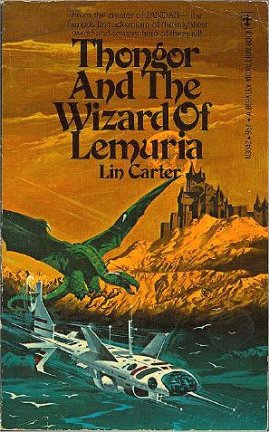 .
.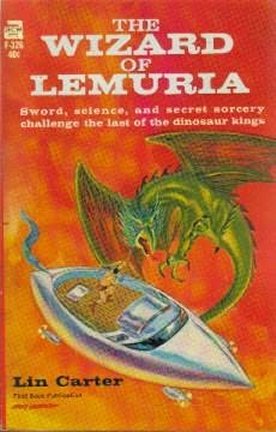 |
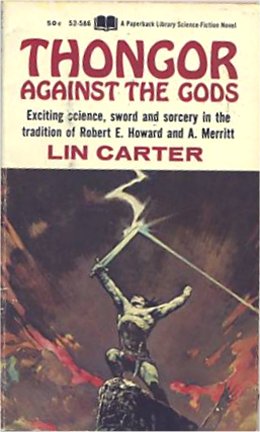 .
.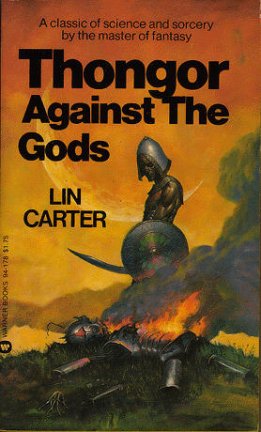 |
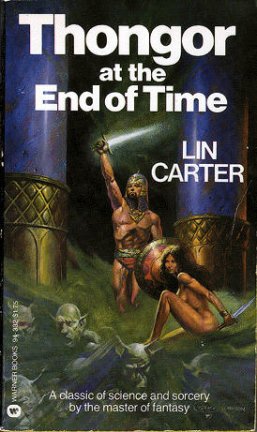 .
.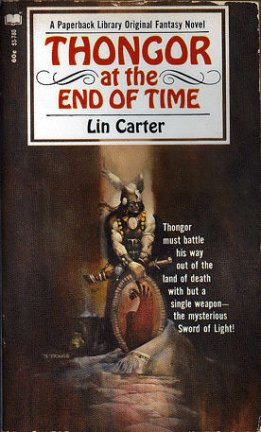 |
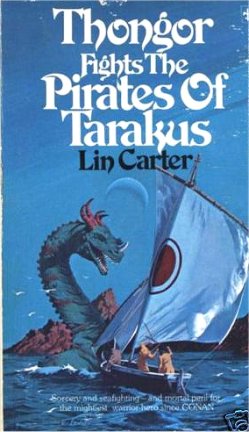 .
.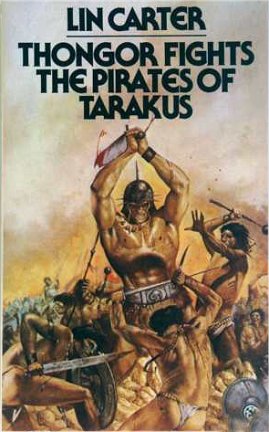 |
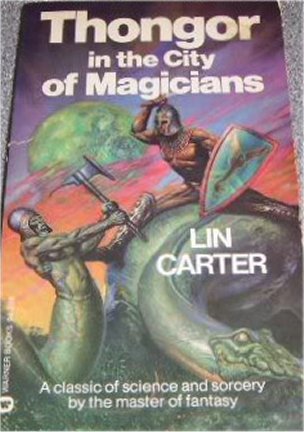 .
.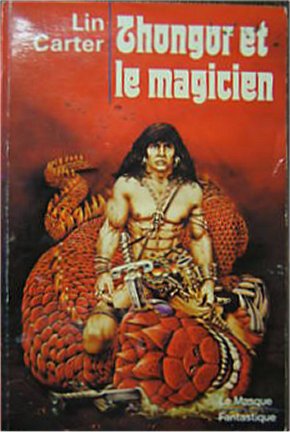 |
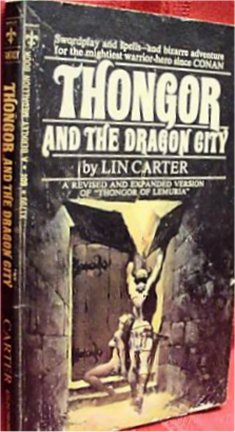 .
.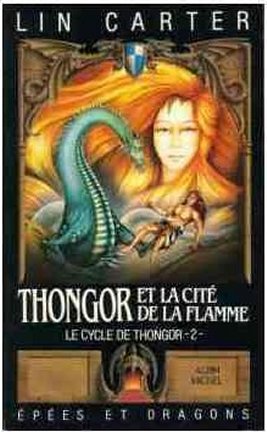 |
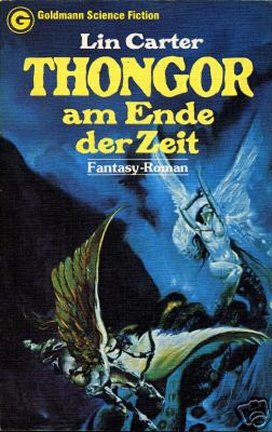 .
.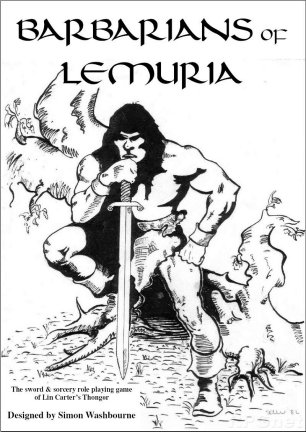 |
The ERB / Lin
Carter Connection in ERBzine
"Zanthodon"
Overview by Steve Servello
Carter
Memoriam
Secret
Masters of Callisto By Charles R. Rutledge: 12 Chapters
WORLD
OF THE GREEN STAR
A Review of the Lin Carter "Green Star" Series
by Steve Servello
More Lin Carter features by Den Valdron
|
for Den Valdron's Fantasy Worlds of ERB |

WEBJED:
BILL HILLMAN
Visit
our thousands of other sites at:
BILL
AND SUE-ON HILLMAN ECLECTIC STUDIO
All
ERB Images© and Tarzan® are Copyright ERB, Inc.- All Rights Reserved.
All
Original Work ©1996-2010 by Bill Hillman and/or Contributing Authors/Owners
No
part of this web site may be reproduced without permission from the respective
owners.